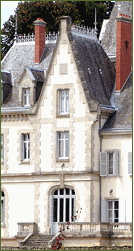|
The remarkable landscape of the Loire Valley, with its chateaux
and more particularly its many cultural monuments, illustrate to an exceptional degree the
ideals of the Renaissance period.
The Loire Valley has a marvellous landscape of great beauty, containing historic towns and
villages, great architectural monuments, many chateaux (over 300 in total), and, of
course, what would a visit to France be without tasting one or two of those fine wines!
The chateaux represent a nation of builders which started with the necessary castle
fortifications in the 10th century, following on to the magnificent chateaux that were
built at least a thousand years later.
When the French kings began constructing their huge chateaux here, the nobility, not
wanting to, or even daring to be far away from the seats of power, decided to followed
suit and their presence in this lush green, fertile valley with its moderate climate,
began attracting the very best landscape designers.
By the middle of the 16th century, King Francois I, had shifted the centre of power from
the Loire in France back to the ancient capital Paris.
As he went, so did the great architects, but the Loire Valley continued to be the place
where most of the French royalty preferred to spend most of their time.
The French Revolution saw an almost overnight impoverishment of nobility after at least
one of the family members lost their head to the guillotine. And, unfortunately,
this meant that many chateaux were ransacked, with the treasures being stolen, and some
were totally destroyed.
During World War I and World War II, some
chateaux were commandeered as military headquarters and some never went back to the
original heritage, yet have been taken over by the National Government and are now major
tourist sites, which can attract many thousands of visitors each year.
Others chateaux today are privately owned and a few are willing to open their doors for
tourist visits, while others are operated as hotels or bed and breakfasts, so you can
always stay overnight!
|
|





